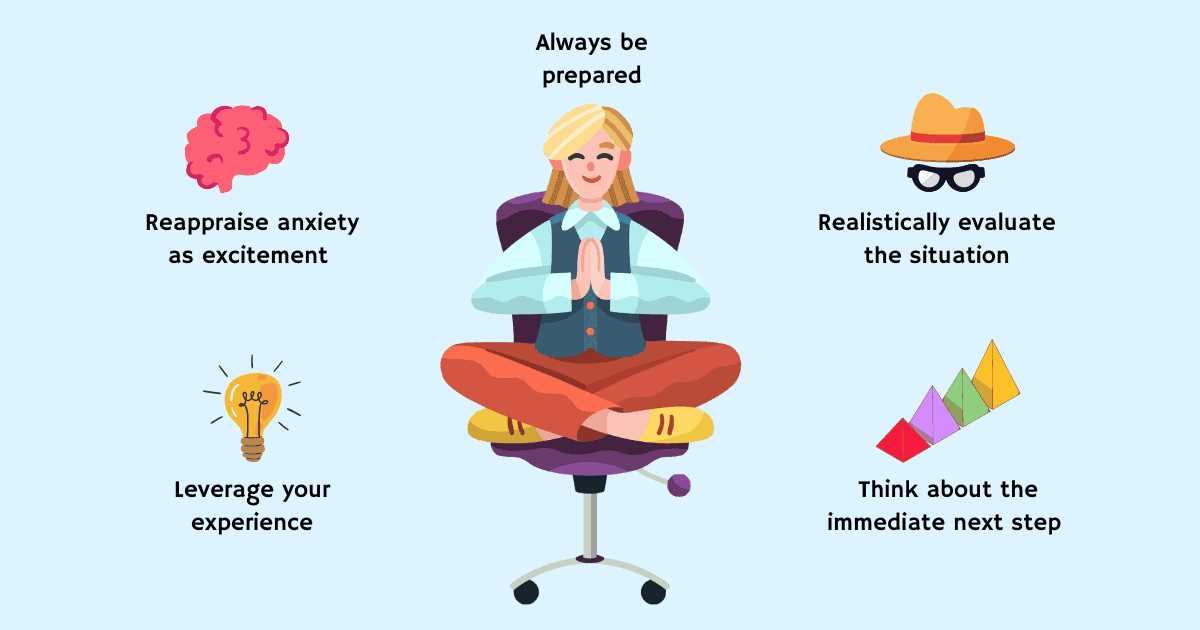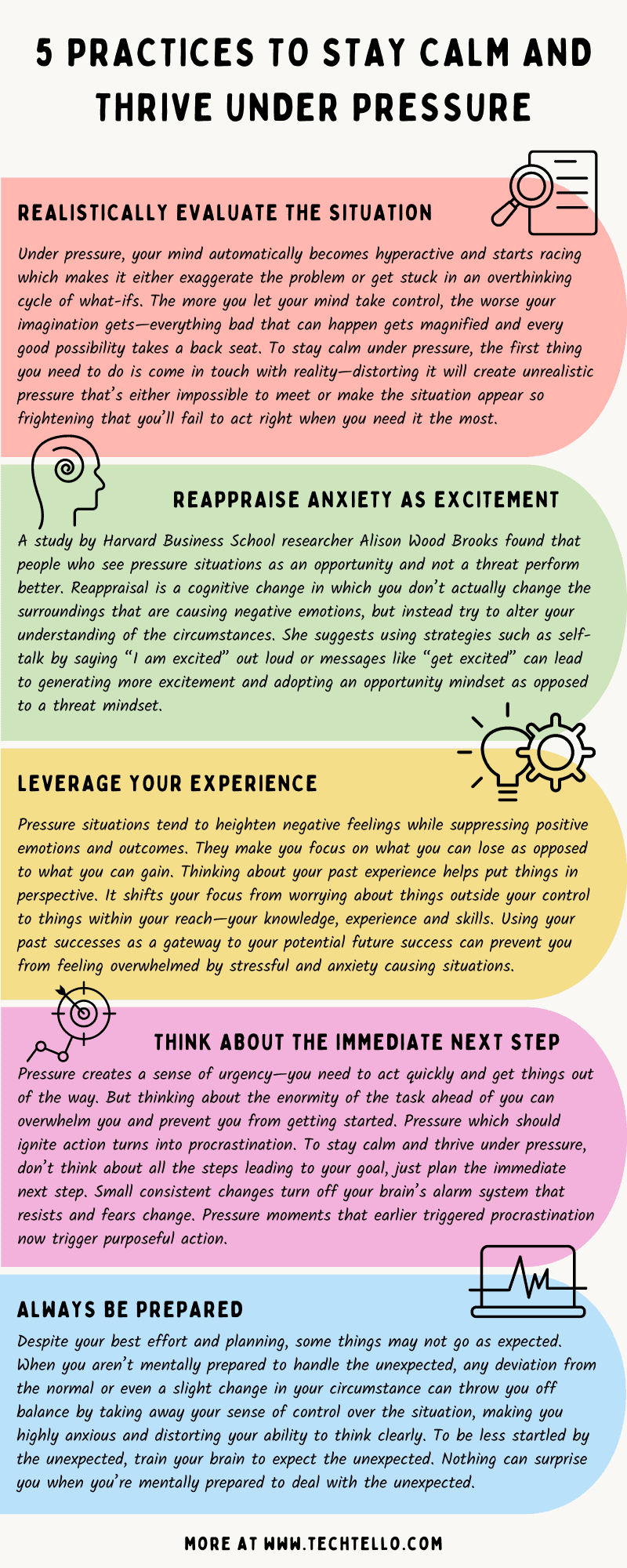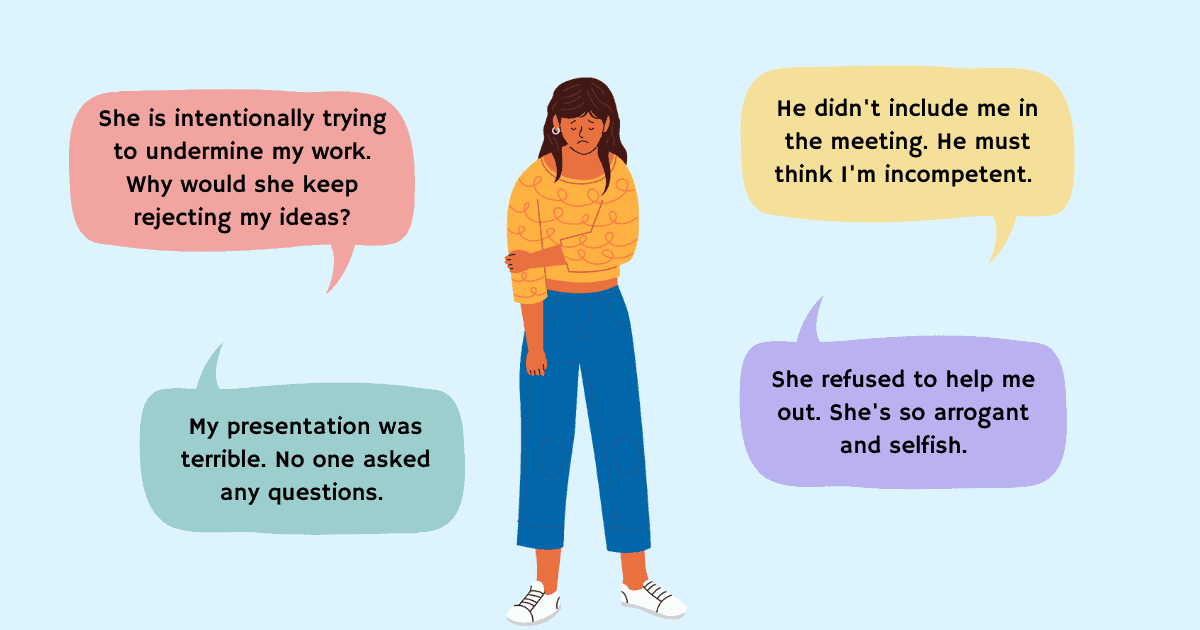How To Stay Calm and Thrive Under Pressure

How can you bring your best to every situation when dealing with the pressure of high expectations?
You know that you can’t screw up when doing something that matters to you or when you really care about the outcome, and yet high pressure situations make many people react poorly and lose their calm. It leads to poor choices, bad decisions and can sometimes even lead to inaction.
The higher the stake, the higher is the cost of not being in control. Losing your calm and shutting people out when work gets a little bit overwhelming or feeling so paralyzed by pressure that you get stuck in an overthinking cycle hurts your productivity and performance.
For example:
Making a key strategy decision for your organization.
Presenting your ideas to a large audience.
Negotiating a big deal with a client.
These are great opportunities where pressure is inevitable and yet you need to be confident and aim high.
When we aim high, pressure and stress obligingly come along for the ride. Stuff is going to happen that catches us off guard, threatens or scares us. Surprises (unpleasant ones, mostly) are almost guaranteed. The risk of being overwhelmed is always there. Regardless of how much actual danger we’re in, stress puts us at the potential whim of our baser—fearful—instinctual reactions.
— Ryan Holiday, The Obstacle Is The Way
You may have all the expertise, skills and the knowledge in the world to do well, but if you don’t know how to handle pressure situations well—you lose control of your emotions or see the situation as a threat—pressure will make you do worse, and lead you to fail utterly.
Keeping your calm during challenging times, ability to gauge the situation with a clear head and acting deliberately instead of reacting to the situation is crucial to lead under pressure.
Here are the 5 strategies I have used in my career to stay calm and thrive under pressure:
Realistically evaluate the situation
Under pressure, your mind automatically becomes hyperactive and starts racing which makes it either exaggerate the problem or get stuck in an overthinking cycle of what-ifs.
The more you let your mind take control, the worse your imagination gets—everything bad that can happen gets magnified and every good possibility takes a back seat. Catastrophic thinking that involves exaggerating the negative consequences of a situation and imagining the worst possible outcomes takes over.
To stay calm under pressure, the first thing you need to do is come in touch with reality. Decatastrophizing will shift the focus away from these catastrophic thoughts and replace them with more balanced and realistic ones. To do this, ask these questions:
- What exactly is the problem or situation you’re dealing with?
- What’s making it stressful?
- Are these real expectations or is it the result of self-imposed pressure?
- What’s the worst that can happen? How likely is it on a scale of 1 (not at all likely) to 5 (very likely).
- What’s the best case scenario? How likely is it on a scale of 1 (not at all likely) to 5 (very likely).
- What techniques or strategies can you use to cope with the catastrophe if it does happen?
- If the catastrophe occurs, what are the chances you’ll be okay in 1 week, 1 month and 1 year from now?
You have to stay realistic about the facts of your situation—distorting it will create unrealistic pressure that’s either impossible to meet or make the situation appear so frightening that you’ll fail to act right when you need it the most.
Self-Compassion Workbook
Cultivate kindness and strength in the face of difficulty and foster a new, more gentle and loving perspective on your struggles.
Reappraise anxiety as excitement
A study by Harvard Business School researcher Alison Wood Brooks found that people who see pressure situations as an opportunity and not a threat perform better—those who reappraise anxiety as excitement end up showing more enthusiasm and performing better in subsequent tasks.
Reappraisal is a cognitive change in which you don’t actually change the surroundings that are causing negative emotions, but instead try to alter your understanding of the circumstances.
She suggests using strategies such as self-talk by saying “I am excited” out loud or messages like “get excited” can lead to generating more excitement and adopting an opportunity mindset as opposed to a threat mindset. Reappraisal from anxiety to excitement positively correlates with better results in a stressful situation and improves subsequent performance.
But aren’t we always told to act cool and have a calm and confident demeanor under pressure?
Brooks’ study shows that it doesn’t work. In her experiments she found out that people who talked about being excited just before the task significantly outperformed those who talked about being nervous, or calm, or were told to try to remain calm. She says “the more often individuals reappraise their anxiety as excitement, the more likely they may be to trigger upward motivational spirals, and the happier and more successful they may become.”
Instead of trying to “Keep calm and carry on,” perhaps the path to success begins by simply saying “I am excited.”
In Psyched Up, Daniel McGinn draws upon Brooks’ study and explains this further:
Brooks says “People have this really strong intuition to try to calm down in stressful situations. You hear it all the time. People either actively say, ‘Calm down,’ or they say, ‘Don’t be anxious.’ The hitch is that it seems quite difficult to find strategies to actually do that.”
In a perfect world, it might be possible to reappraise one’s feelings of nervousness into an unaroused, nonchalant calm. Brooks suggests that in reality, that’s too great a leap. “The argument is that anxiety and excitement are actually very, very close, but that anxiety and calmness are too far apart,” she says. So instead of aiming for calm, the smarter strategy is to force yourself to make the more subtle, achievable mental shift from nervousness to excitement.
Leverage your experience
Pressure situations tend to heighten negative feelings while suppressing positive emotions and outcomes. They make you focus on what you can lose as opposed to what you can gain.
Thinking about your past experience helps put things in perspective. It shifts your focus from worrying about things outside your control to things within your reach—your knowledge, experience and skills.
Using your past successes as a gateway to your potential future success can prevent you from feeling overwhelmed by stressful and anxiety causing situations.
When working under pressure, think about a similar problem that you solved before:
- What are the similarities between the two situations? What are the differences? Consciously evaluating this helps you understand that no two situations are the same, but you can always leverage knowledge and experience from one to another.
- What specifically did you do in those situations to perform at your best?
- Which behaviors were helpful?
- Which behaviors were damaging and prevented you from achieving your goal?
- How can you leverage some of that learning and adapt it to the current situation?
Thinking about a similar problem that you’ve solved before makes the experience less frightening.
For example:
Dealing with the pressure of a job interview? Think about your past interviews where you left a positive impact on the interviewer.
Worried about giving a presentation? Think about the skills you demonstrated in your previous presentations that left everyone inspired.
Pressure moments are filled with uncertainty—you are uncertain that you will deliver the goods. Remembering your past successes ignites confidence—you did it before and you can do it again. As your confidence increases, uncertainty (anxiety) and pressure are diminished, freeing you to approach the task with your best effort. Nervousness becomes transformed into positive enthusiasm that is directed to the task, rather than anxious thinking that is distracting.
— Hendrie Weisinger, Performing Under Pressure
To stay calm and thrive under pressure, say it out loud “I’ve done it before. I can do it again.”
Think about the immediate next step
Pressure creates a sense of urgency—you need to act quickly and get things out of the way. But thinking about the enormity of the task ahead of you can overwhelm you and prevent you from getting started.
Pressure which should ignite action turns into procrastination. You keep putting things off with excuses that appear completely justified in those moments—not enough motivation, not the right time, don’t have the clarity or keeping busy with trivial tasks while ignoring important and complex tasks that must be done to accomplish your goal.
In One Small Step Can Change Your Life, Robert Maurer states “Radical change is like charging up a steep hill—you may run out of wind before you reach the crest, or the thought of all the work ahead makes you give up no sooner than you’ve begun.”
He suggests another path altogether “one that winds so gently up the hill that you hardly notice the climb. It is pleasant to negotiate and soft to tread. And all it requires is that you place one foot in front of the other.”
This strategy of putting one foot in front of the other—taking small steps for continual improvement—is called Kaizen. Lao Tzu, the Chinese philosopher captured the spirit of Kaizen in his famous saying “A journey of a thousand miles begins with a single step” and John Wooden, the legendary basketball coach highlighted the importance of small improvement “When you improve a little each day, eventually big things occur. When you improve conditioning a little each day, eventually you have a big improvement in conditioning. Not tomorrow, not the next day, but eventually a big gain is made. Don’t look for the big, quick improvement. Seek the small improvement one day at a time. That’s the only way it happens—and when it happens, it lasts.”
Small consistent changes turn off your brain’s alarm system that resists and fears change. These small steps may seem trivial at first, but they soon turn into meaningful habits. Pressure moments that earlier triggered procrastination now trigger purposeful action.
To stay calm and thrive under pressure, don’t think about all the steps leading to your goal, just plan the immediate next step. One foot in front of the other requires:
- Identify a small step and put it into action.
- Act, revise and repeat step 1 till you seek the second-level challenge.
- Act, revise and repeat the second-level challenge till you desire the third-level challenge.
- Repeat this for the third, fourth…nth level challenge.
And just like that, step at a time, your effort will compound into a much bigger change. Goals that appeared too big at first will be now within your reach. There will be no resistance to push aside or delay the task when working under pressure. Taking small steps to make continuous progress will become a part of your identity. It’s what you’ll do.
To stay calm and thrive under pressure, ask yourself “What’s the first small step you can take?”
Implementation Intentions Worksheet
Develop an action plan to avoid distractions, stay on track and achieve your goals with this template.
Always be prepared
Despite your best effort and planning, some things may not go as expected.
When you aren’t mentally prepared to handle the unexpected, any deviation from the normal or even a slight change in your circumstance can throw you off balance by taking away your sense of control over the situation, making you highly anxious and distorting your ability to think clearly.
When dealing with high pressure, unwelcomed events are not only dreadful, they appear devastating. You end up making bad choices and regretful decisions.
In life, there will be times when we do everything right, perhaps even perfectly. Yet the results will somehow be negative: failure, disrespect, jealousy, or even a resounding yawn from the world.
— Ryan Holiday, Ego Is The Enemy
To be less startled by the unexpected, train your brain to expect the unexpected. To stay calm under pressure, be prepared to face the worst using the pre-mortem technique:
- Place yourself into the future and look back.
- Visualize the project, task or whatever you intend to do has gone horribly wrong. Create a mental picture in your mind using “what-if” scenarios.
- Work backwards to identify what mistakes might cause it to fail.
- Create a plan to solve these issues—address the risks and obstacles, thereby making it easy to deal with them when they arise.
Nothing can surprise you when you’re mentally prepared to deal with the unexpected. Consciously thinking about uncomfortable and unwanted situations has another advantage—it builds the mental muscle to embrace discomfort instead of running away from it.
You cannot predict the future, but you can plan for it. You cannot control the uncertain outcomes, but you can be better prepared to focus on the controllable results.
When performing under pressure, knowing the worst that can happen can lift the pressure off by being less dependent on the outcomes and putting more focus on the effort.
Summary
- Pressure is inevitable when you’re trying to do worthwhile work. Reacting to pressure can put you at a disadvantage as you end up making poor choices and terrible decisions.
- Leading under pressure requires the ability to keep your calm and think with a clear head—being purposeful in the way you behave and act.
- Pressure leads to exaggeration—you imagine the worst possibility and consider it your best case. Seeing the situation for what it is without distorting facts or reality is critical to thrive under pressure.
- Anxiety and stress tag along when pressure shows up. However, research shows that reappraising anxiety as excitement makes you view pressure situations as opportunities and not a threat which leads to more enthusiasm and better performance in subsequent tasks.
- Pressure situations can make your knowledge, skills and experience irrelevant if you don’t know how to deal with it. Recalling past experience and leveraging it to deal with the current situation can diffuse pressure by reminding you that you’ve done it before and you can do it again.
- Pressure makes it hard to visualize the end goal and all the steps you need to take to get there. In some cases, pressure can make you feel so overwhelmed that you stop even before you’ve started. To prevent this from happening, take consistent small steps towards your goal. Putting one foot in front of the other is a powerful strategy to make progress without fear or self-doubt.
- Finally, remember that failures and mistakes are inevitable even with the best strategies and plans in place. Train your brain to expect the unexpected.






























